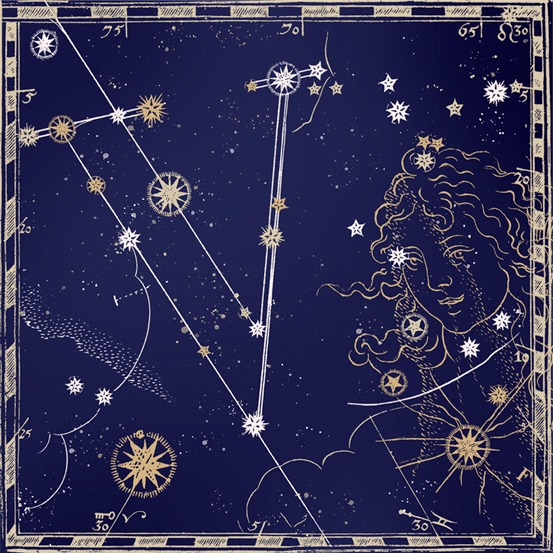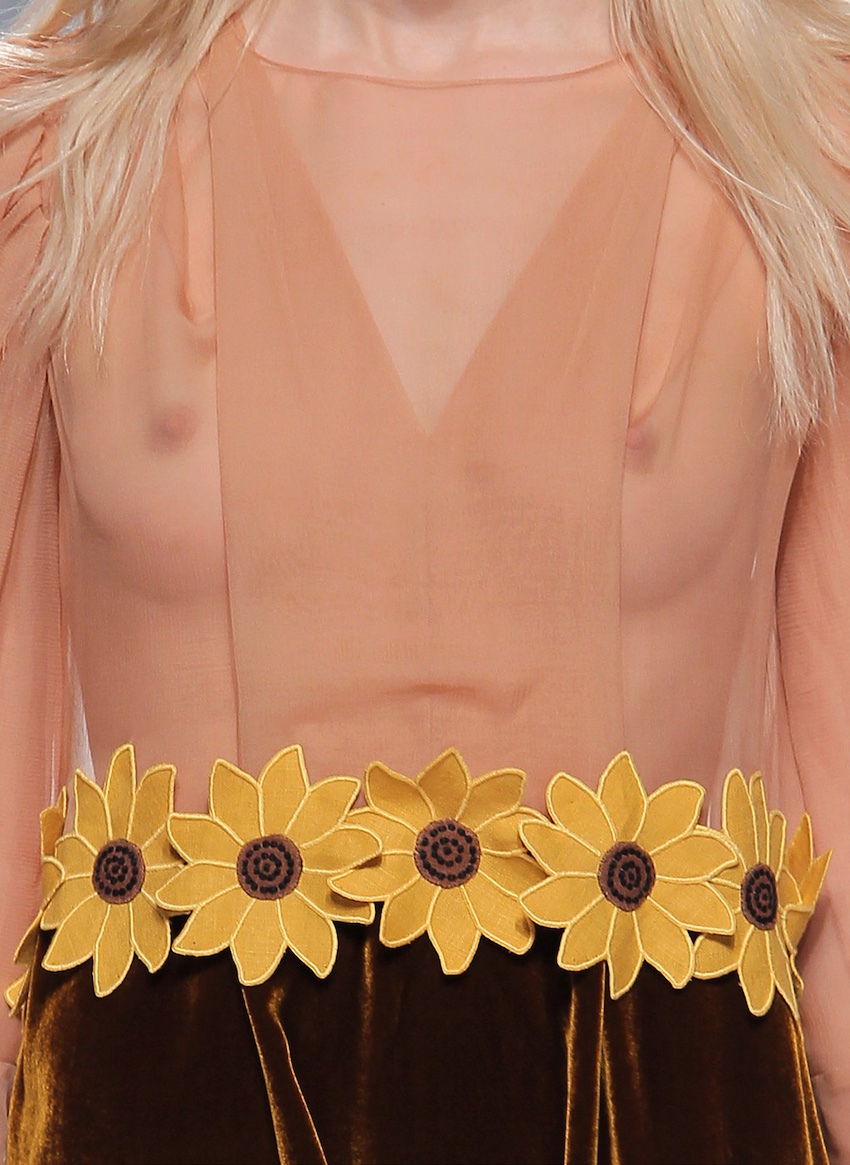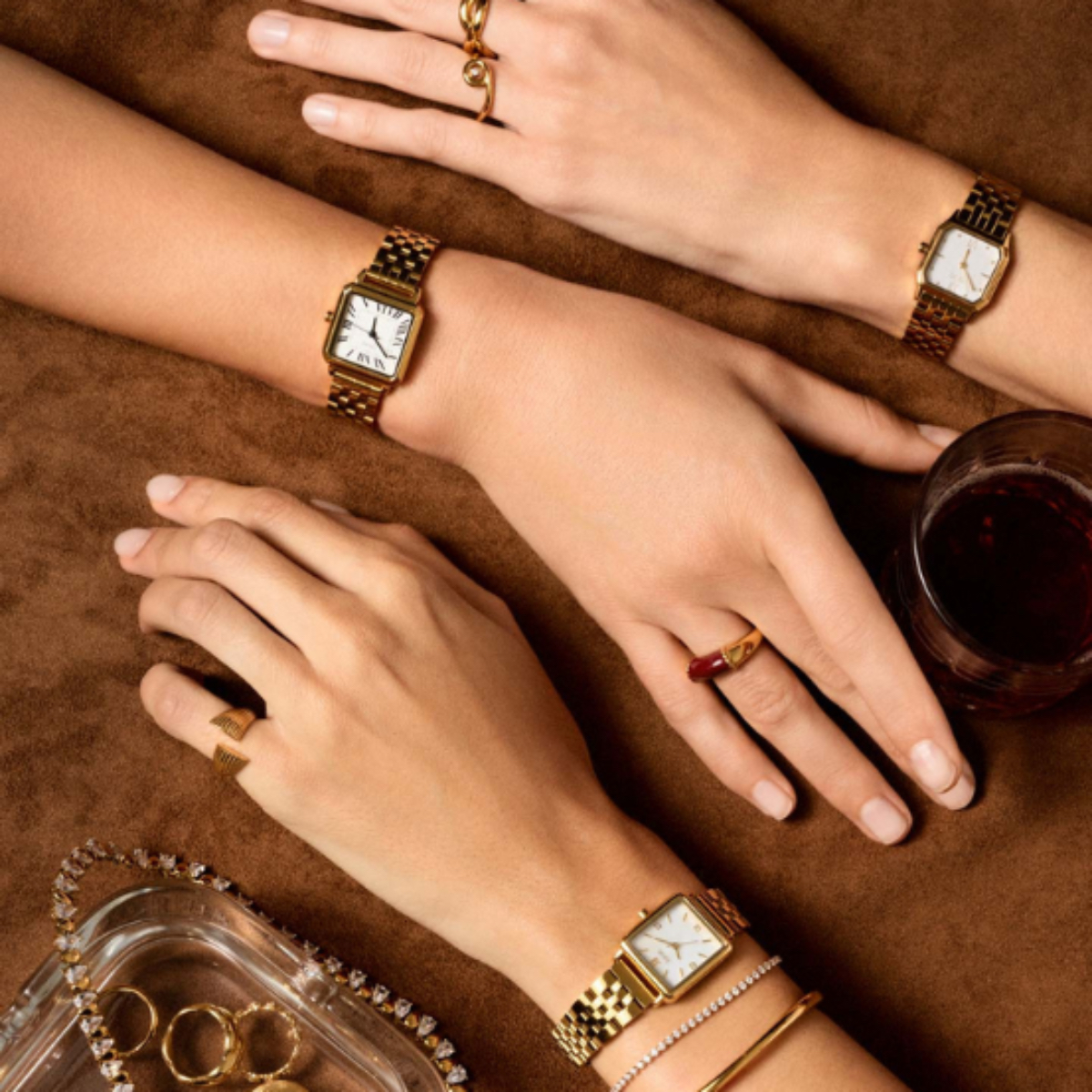Bordado Madeira at Filipe Faísca's FW2018 © ModaLisboa
It’s no coincidence that Madeira’s folklore has dedicated a theme from its dance repertoire to it: embroidery - and not just Bordado Madeira - is part of our national identity and is crucial for promoting the country, in general, and each region, in particular. They are so very typical that they go beyond borders so that, more than a souvenir, they are a must in fashion design.
“Oh embroider, dear daughter, embroider well. At home, my dear daughter, everyone embroiders. The father embroiders, and the daughter, and the mother - and me too.” This is how the folkloric theme of Bailinho da Madeira which titles this text, goes on from there. Fiction may be out of step with reality: at home, dear daughter, almost no one embroiders, but even so, the embroidery and lace that are so typically portuguese continue to enjoy national pride, being recovered by brands, popularized in trends, preserved by those who want to continue telling its story, hoping that this impact will revive and increase an art that is closely linked to Portuguese DNA and that serves as a calling card not only for the country, but also for regional idiosyncrasies. Embroidery - which refers, in a broad sense, to a wide range of techniques and materials that result in the creation, using needles and thread, of decorative motifs on a fabric - differs from place to place depending on the techniques used, materials and even the type of adornment design. For example, the lovers scarves from Minho are colorful and display romantic motifs and phrases, but others are mostly white, like those from the Azores. In the case of the aforementioned Bordado Madeira, it has been, since the beginning, characterized by naturalistic motifs largely inspired by the island's scenes and, probably due to its noble origin (they began to be created by noblewomen), requires that the materials are also noble, such as natural silk, linen, organdy and cotton. Several stitches are used, all made by hand and authenticated by the Instituto do Vinho do Bordado e do Artesanato da Madeira (only pieces with this seal can be considered Madeira embroidery). If we enter the realm of lace, many other peculiarities emerge, as in the case of Renda de Bilros, produced by the skillful crossing of threads, with the help of bobbins and pins and using a cushion as its base. This art, once common in many centers along the coast, is now found more significantly in Peniche and Vila do Conde, but throughout the country you can find other more common types of lace, such as needle, fillet and thread lace. Trying to condense in one article the multiplicity of techniques and types of embroidery (from Viana and Guimarãess, to Tibaldinho and the Azores, to tapestries from Arraiolos, if we want to extend it to all types of manual textile work) existing in Portugal - even just those who enjoy more popular recognition within and beyond borders - it's a herculean task. Mainly because unraveling the skein of this multiplicity of points is to show how unknown the detail of this topic is to us, unfolding in techniques, in stitches, in materials, in drawings, in narratives, which shows how important it is to continue telling their history so that they become part of the common lexicon.
Part of this story is expected to also be told by Fashion - in fact, as it has been. It's not difficult to do it, actually: the richness of the types of Portuguese embroidery and lace has plenty to offer when it comes to creativity and some brands and designers have known how to make use of this. For example, just browse through the Portuguese e-shop Behén, a brand owned by Joana Duarte, to find a list of “Viana” shirts, with their delicate allusions to the flora of the area and the eternal heart of Viana. In tones, the traditional red and blue on white, but also color-block options that break with the typical canons without compromising the Portuguese legacy. In this year's winter collection, Duarte once again showcased elements of Portuguese folklore such as this Viana Embroidery, but also Madeira Embroidery and, in a debut, Embroidery of Glória do Ribatejo. This is not the first time that Duarte has supported Portugueseness; In fact, her challenge as founder and creative director is that Behén can be - and is - a celebration of national crafts, in which this genre of embroidery art has played a central role (in March 2022, it also included Terceira embroidery and weaving of São Jorge, Azores, in the proposals for winter this year). But before Joana Duarte gave birth to Béhen, in 2020, other national designers had already drawn on the country's roots to make a contemporary tribute to its antiquity. Filipe Faísca, in his autumn/winter 2018 collection, made it all about Madeira Embroidery, using it as a canvas for a narrative in which Creativity and History are interconnected. Not being a stranger to the combination of the legacy of Portuguese craftsmanship with his proposals, in this collection in particular, Faísca made this type of artisanal embroidery the guiding thread of a season that reflects the richness of this art, whose origins date back to the 15th century, in pieces of womenswear that follows the feminine and sophisticated lines of the national designer. Entitled 6th sense, Madeira Embroidery, which over the years has become popular in this or that piece of clothing, but above all in scarves and tablecloths, gained a new paraphernalia of options in party and cocktail dresses, coats, pants and skirts.
Countless other names in national fashion sought references from this heritage to bring them into the 21st century, but this inspiration was not limited to Portuguese territory. In September 2014, Chanel featured some Bordado Madeira accessories on its catwalk: the fashion house, at the time, did a partnership with the Madeira company Bordal, ordering 120 collars embroidered with eight designs from the Madeira factory and three from the French company, which were later adapted. The result arrived in stores the following spring-summer, immaculate white with the embroidery relief easily recognizable on various models of shirts and blouses. More recently, the Italian Max Mara made the “boyfriend scarf” the invitation for a Resort collection inspired by Portugal and Natália Correia: they then appeared as emblems on t-shirts, but very little distorted from the original version, even in its manufacture, after Sofia Lucas, editor in Chief of Vogue, shared the story of the traditional piece with Ian Griffiths, the house's creative director, which he fell in love with immediately. “Sofia Lucas, very generously, explained to us this tradition of scarves, in which single women embroidered messages, with flowers and hearts, for their intended and loved ones, and dropped them in churches... if their loved ones caught them and put them in their pockets, it was practically as if they were engaged. It's a charming story - and it's poetry, just like Natália Correia, just like fado... it's all about poetry. And we wanted to celebrate this Portuguese tradition, but it would be wrong to take this idea of scarves and make them outside of Portugal, so we worked with local artisans and made them all here, by hand, and then they were applied to t-shirts, like a panel, on the front.”, he shared with Vogue Portugal, on the day the collection, appropriately titled Vai Lenço Feliz, paraded in the gardens of the Calouste Gulbenkian Foundation. It's a narrative that's difficult to resist: popularized from the 19th century onwards, these Minho’s love scarves were used by girls of marriageable age, who embroidered them poetically with verses and symbolic designs (from hearts to birds and flowers), with the aim of giving them to their loved one if he was absent or even as a way of winning over a fiancé. Used across all social classes, it was normal for the more aristocratic versions to be rigorous in their finishing touches and the less noble versions to be more crude and even include some spelling errors, which in fact only added to their charm. The story behind the stitch is fascinating, but even without the story, these linen or cotton squares immediately appeal for their colorful and naive aesthetic, continuing as an attractive accessory for more than just a group of tourists in a souvenir shop.
In fact, a linear appeal to almost all embroidery: the manufacture and its texture bring delicacy and care to the piece they adorn and it is no coincidence that this ancient art has, even if slightly less popular with the introduction of automation and other modern distractions, survived with the same mastery and symbolism as in its beginnings. And the “millennial” reference is not a slip or metaphorical, there are mentions of this use of stitches, commonly known as embroidery, since prehistoric times, in the sewing and ornamentation of leather clothing, mentions that are also associated with the pomp of nobility and religious circles, in ancient civilizations. The panoply of techniques that are known today is due to the successive presence of different peoples and cultures in the national territory, who left embroidery secrets and different materials, today an integral part of the repertoire of the art of embroidery. As with other artistic aspects, embroidery was largely influenced by contact with aesthetics and practices coming from abroad, especially with the opening of sea routes. Throughout the evolution and transformation of this type of craftsmanship, the increase in its production and uses is notable, particularly from the 19th century onwards: embroidery becomes a preponderant activity in the female universe, not only as a hobby, but also as a contribution to the family budget. The introduction of female crafts into the curriculum of girls' schools also reinforces the learning that took place in the family, and also inevitably culminates in the increase in commercial productions (during the first half of the 20th century, the impetus was also given by cultural policies of the Estado Novo, integrating the domain of cultural heritage). Technology may have slowed down manual production, but it does not diminish the interest of those who now discover it, making it easy to admire and value the workmanship behind a beautiful, handcrafted embroidered piece. It is no coincidence that embroidery on clothing and accessories enjoys (or once enjoyed), in addition to its ornamental function, a social and symbolic function, with connotations of wealth, social status and economic power. Which is curious, because it also proved to be, as a mandatory activity in any family, whatever their income, a more accessible way of decorating clothing and home, either because it is a homemade technique adaptable to different materials, or because of its creative versatility. Today, this artistic scope continues to be put to (good) use in countless fashion proposals. Admittedly national or not, the main brands do not neglect to use the technique to elevate any pieces, both in winter and in the hot season, but with a special focus on springtime proposals. Usually, decorating with embroidery clothes in linen or white cotton reminisces summer collections and this season is no exception. From dresses with straight lines ripped by embroidered symmetry to bandeau “sheets” full of embroidered floral motifs from Balenciaga, summer on the catwalk was not shy in this art, especially in completely white looks. Luisa Beccaria, Gabriella Hearst, Valentino, Michael Kors, Chloé, Dior... between lace and embroidery, the advent of heat leaves no stone unturned in style and proves that embroidery, with more or less fans, is - and should be - a timeless art. And its promotion on the main fashion stages should be, more than a creative manifestation for the SS24 wardrobe, a draw for the interest of new generations in perpetuating this manufacture and craftsmanship. An appeal that, “at home, my dear daughter, everyone embroiders”. Even the father, the mother and me too.
Translated from the original in Vogue Portugal's "Portugal With Love" Issue, published June 2024. Full stories and credits in the print issue.
Most popular
.jpg)

Relacionados

O que lhe reservam os astros para a semana de 30 de dezembro a 5 de janeiro
30 Dec 2025
.jpg)





.jpg)
